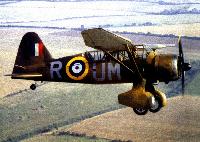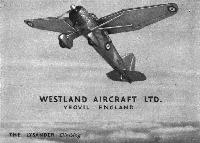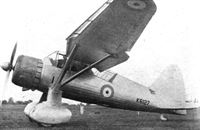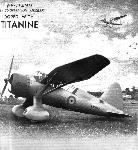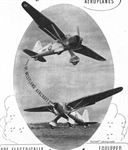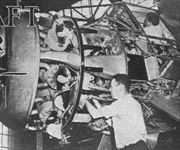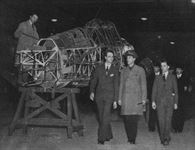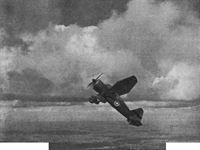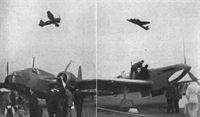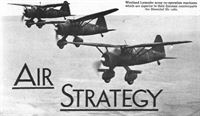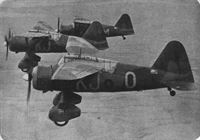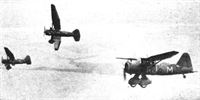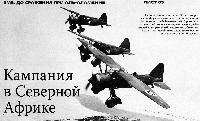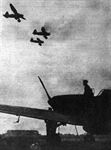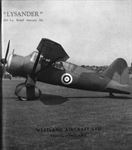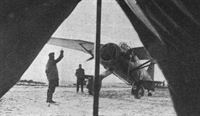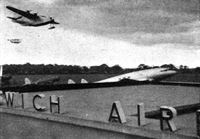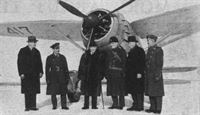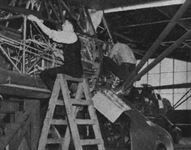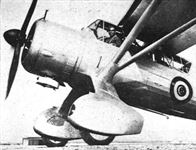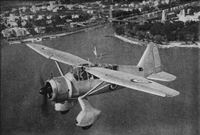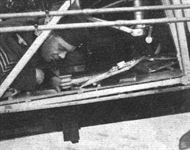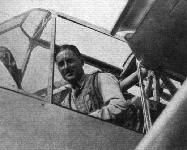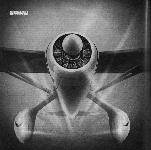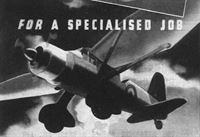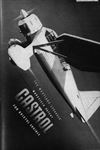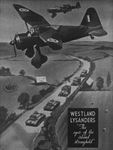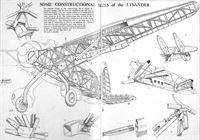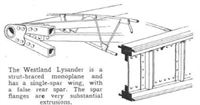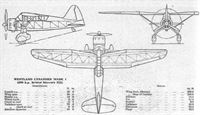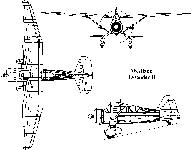
Описание
Страна : Великобритания
Год : 1936
Самолет непосредственной поддержки сухопутных войск
Варианты
- Westland - Lysander - 1936 - Великобритания
- Westland - P.12 - 1940 - Великобритания
Lysander
Многоцелевой самолет взаимодействия с сухопутными войсками, одномоторный моноплан с верхним расположением крыла и неубирающимся шасси (колеса в обтекателях). Спроектирован в КБ фирмы "Уэстленд эйркрафт" под руководством А. Дэвенпорта и В. Петтера. Опытный образец "Лизандра" впервые взлетел 15 июля 1936 г. Серийный выпуск самолета был освоен с апреля 1938 г. Строился на заводах "Уэстленд" в Еовиле и "Нэйшнл стил кар корпорейшн" в Мелтоне (Канада). Всего выпущено 1674 экз. (с буксировщиками мишеней ТТ IIA).
Экипаж самолета - 2 чел. (у типов II(SD) и IIIA(SD) -1 чел.+2 чел. пассажиров). Вооружение 3-4x7,69, бомбы до 320 кг.
"Лизандр" состоял на вооружении в Великобритании с мая 1938 г., в Ирландии - с июля 1939 г., в Египте и Канаде-с сентября 1939 г., в Турции - с февраля 1940 г., в Финляндии - с марта 1940 г., в Индии - с августа 1941 г., в Португалии - с сентября 1943 г.
Выпускались три основные серийные боевые модификации:
- "Лизандр" I с мотором "Меркьюри" XII, вооружение 3x7,69;
- "Лизандр" II с мотором "Персеус" XII, вариант IIA с вооружением 4x7,69, в Канаде строились машины этого типа с отоплением кабины;
- "Лизандр" III с мотором "Меркьюри" ХХ/30, имел варианты: IIIA с вооружением 4x7,69, III(SD) - специальный самолет связи без вооружения с лестницей на борту, IIIA(SD) - вариант предыдущего со стандартным вооружением, III(SCW) - вариант с увеличенной дальностью полета (с подвесным баком под фюзеляжем).
Перед началом Второй мировой войны "лизандры" базировались в метрополии, Египте и Палестине. При переброске британского экспедиционного корпуса во Францию вместе с ним туда прибыли четыре эскадрильи этих машин. В мае 1940 г. они как штурмовики и разведчики действовали в Бельгии, Голландии, Северной Франции. Позднее эти самолеты прикрывали эвакуацию из Дюнкерка. С июня 1940 г. "лизандры" вели разведку в Греции.
С апреля того же года они поддерживали наступление англичан и южноафриканцев на эфиопско-кенийской границе. Их там применяли и как штурмовики, в частности, при взятии Керена в феврале 1941 г. В декабре 1941 г. - январе 1942 г. английские "лизандры" действовали в Бирме. Там же до конца 1942 г. летали и индийские машины.
С июля 1940 г. "лизандры" начали использоваться спасательными подразделениями в метрополии. В этом качестве они служили до середины 1942 г. С сентября 1941 г. применялись для специальных операций - высадки агентов и выброски грузов в тылу у немцев. Эскадрильи и звенья специального назначения летали на них до августа 1944 г. в Европе, до апреля 1945 г. на Балканах, до октября 1945 г. на Дальнем Востоке. Финские "лизандры" с июля 1941 г. воевали в районе Ладожского озера как разведчики и легкие бомбардировщики. С середины войны они перешли на ночные полеты. Выведены в тыл в августе 1944 г.
"Лизандр" сняли с производства в январе 1942 г. Последние машины этого типа летали в ВВС Великобритании, Ирландии и Финляндии до 1946 г., в Египте - до 1947 г.
"Лизандр" I||
Размах:||15,25 м
Длина:||9,15 м
Моторы, количество х мощность:||1x890 л.с.
Взлетная масса, максимальная:||2683 кг
Максимальная скорость:||352 км/ч
Практический потолок:||7900 м
Дальность:||965 км
Описание:
- Lysander
- Westland Lysander
- Flight, June 1938
FOR ARMY CO-OPERATION - Flight, November 1939
Britain's Military Aircraft
Фотографии
-
АвиаМастер 2004-02 / К.Кузнецов - Бедная "Лиззи": многоцелевой самолет "Лайсендер" /Монография/
Lysander Mk.I из 239-го дивизиона Королевских ВВС Великобритании, 1941г.
-
Авиация и Время 2001-05 / М.Жирохов, Д.Шевчук - ВВС Израиля, 1948-49гг. (2)
Регистрационный номер: Y505 [2] Lysander Mk.I из 1-й АЭ Королевских ВВС Египта, а/б Алмаза
-
АвиаМастер 2004-02 / К.Кузнецов - Бедная "Лиззи": многоцелевой самолет "Лайсендер" /Монография/
Регистрационный номер: Y513 Lysander Mk.I из 1-го дивизиона связи Королевских ВВС Египта, 1940-1941г.
-
АвиаМастер 2004-02 / К.Кузнецов - Бедная "Лиззи": многоцелевой самолет "Лайсендер" /Монография/
Lysander Mk.II из 20-го дивизиона Королевских ВВС Великобритании, 1942г.
-
Air International 1987-01 / Model enthusiast
Регистрационный номер: L4767 Westland Lysander II L4767 was delivered at the end of 1939 and in the markings shown here was operated by No 13 Squadron, which served in France until May 1940. Subsequently, L4767 was used by No 7 AACU and No 2 Squadron before transfer to the Indian Air Force.
-
Air International 1987-01 / Model enthusiast
Регистрационный номер: R9125 [2] Lysander III R9125 was one of a 100-aircraft production batch delivered in July and August 1940, and served first with No 225 Squadron as shown here. It was later converted to a target tug.
-
Мировая Авиация 251
Регистрационный номер: R1999 В ходе битвы за Францию самолеты «Lizzie» британских ВВС использовались в качестве самолетов непосредственной поддержки сухопутных частей, но стали легкой добычей для немецких истребителей. Данный Lysander Mk II принадлежал 225-й эскадрилье.
-
Air International 1987-01 / Model enthusiast
Starting in August 1941, the Indian Air Force received Lysanders transferred from the RAF. They were operated initially by No 1 Squadron, IAF, and subsequently by Nos 2 and 4 Squadrons, with a few also used by No 22 AA Unit for target-towing.
-
АвиаМастер 2004-02 / К.Кузнецов - Бедная "Лиззи": многоцелевой самолет "Лайсендер" /Монография/
Регистрационный номер: P9181 Lysander Mk.II из авиагруппы "Бретань" ВВС "Свободной Франции", аэродром "Зуар" (Чад), январь 1942г.
-
АвиаМастер 2004-02 / К.Кузнецов - Бедная "Лиззи": многоцелевой самолет "Лайсендер" /Монография/
Lysander Mk.II французских ВВС, испытательный центр "Эвиль", 1939г.
-
АвиаМастер 2004-02 / К.Кузнецов - Бедная "Лиззи": многоцелевой самолет "Лайсендер" /Монография/
Lysander Mk.II из 1-й эскадрильи Ирландского Воздушного Корпуса, 1942г.
-
Air Enthusiast 1971-07 / ??? - A pictorial history of Turkish Military Aviation
Westland Lysander II at Yesilkoy, 1940.
-
Air International 1987-01 / Model enthusiast
The Turkish Air Force was one of several pre-war customers for the Lysander, ordering 36 Mk IIs in 1939. They were delivered in February/March 1940 and No 3130 was in service at Yesilkoy in that year.
-
Мировая Авиация 213
Регистрационный номер: V9367 [5] Снятые с фронта на Европейском ТВД, "Lizzie" приняли активное участие в тайных операциях, где пригодились их отличные взлетно-посадочные характеристики. На рисунке - самолет из 161-й эскадрильи специального назначения.
-
Air International 1987-01 / Model enthusiast
Регистрационный номер: V9367 [5] Lysander IIIA V9367, delivered from the Westland Yeovil assembly lines early in 1943, served only with No 161 Squadron - the second of the RAF's Special Duties units - being written off at Tangmere on 17 December 1943. Note the long access ladder of the SD Lysander.
-
АвиаМастер 2004-02 / К.Кузнецов - Бедная "Лиззи": многоцелевой самолет "Лайсендер" /Монография/
Регистрационный номер: LY-118 Lysander Mk.III из 2-й эскадрильи 18-го авиаполка (2/LeLv.16) ВВС Финляндии, 1942г.
-
АвиаМастер 2004-02 / К.Кузнецов - Бедная "Лиззи": многоцелевой самолет "Лайсендер" /Монография/
Lysander Mk.II - буксировщик воздушных мишеней из 8-й школы бомбардировки и воздушной стрельбы (Bombing and Air Gunnery School) Королевских канадских ВВС, 1942-44гг.
-
Авиация и Время 1995-05
Многоцелевой самолет Westland Lysander Mk.III в окраске подразделения Special Operations Executive ВВС Великобритании. На таких машинах осуществлялись ночные спецполеты на территорию оккупированной Франции
-
Air International 1988-02 / Talkback
Регистрационный номер: OO-SOT [3] The "new" Lysander OO-SOT, brought back to airworthiness in Belgium.
-
Aeroplane Monthly 2000-01 / P.Jarrett - Historic colour. Westland Lysander /Pre-WW2 colour photography/
Регистрационный номер: L4805, L4808 This rare colour photograph, taken by H.H. Chapman at either Biggin Hill or Kenley in May 1939, depicts Lysander Mk IIs L4808 and L4805 of 16 Sqn, with a third “Lizzie” just visible at right. The aircraft are fitted with removable stub-wing bomb carriers on each main undercarriage leg. Both aircraft were built by Westland at Yeovil, and were part of a batch of 32 delivered to 16 Sqn in April 1939. Lysander L4808 survived until 1940, when it was destroyed on June 1; its companion L4805 served with 16 and 239 Sqns, 6 AACU, 12 Group AAC Flight and 116 Sqn before becoming an instructional airframe in 1943.
-
Air Enthusiast 1972-07 / H.Taylor - The Westland Lysander /Viewed from the Cockpit/
Регистрационный номер: R9003 [3] The Lysander III R9003 which was restored to flying condition in Canada during 1967 by a team led by Captain Bernard M Lapointe. Three derelict airframes and a new set of wings were used in the project and the Lysander, with a Bristol Mercury XX engine, flew again on 29 December 1967 after some 23 years on the ground. It is now an exhibit in the Canadian National Aeronautical Collection.
-
Aeroplane Monthly 1998-12 / M.Oakey, T.Harmsworth - News
Регистрационный номер: G-BCWU, V9545 Out with a bang: Woodford Lysander G-BCWU/“V9545” suffers a brief intake fire at Duxford’s Autumn Air Show on October 11, 1998, its last UK display appearance.
-
Aeroplane Monthly 1994-05 / Westland Lysander IIIA G-BCWL/"V9281" /Preservation Profile/
Регистрационный номер: G-BCWL [17], V9281 [17] PETER R. MARCH’S colour photograph was taken near Yeovil in June 1993.
-
Моделист-Конструктор Ближние разведчики, корректировщики и штурмовики Второй мировой войны
Регистрационный номер: G-BCWL [17], V9281 [17] Разведчик Уэстленд "Лизандр" (Англия)
-
Aeroplane Monthly 1979-09
Регистрационный номер: G-BCWL [17], V9281 [17] Westland Lysander G-BCWL, restored for Philip Mann by Personal Plane Services at Booker, and now sold to Doug Arnold.
-
Aeroplane Monthly 1994-05 / Westland Lysander IIIA G-BCWL/"V9281" /Preservation Profile/
Регистрационный номер: G-BCWL [17], V9281 [17] -
Мировая Авиация 148
Регистрационный номер: V9367 [5] Вторая мировая война: техника короткого взлета на практике. Трофейный самолет Fi 156 Storch поступил в британские ВВС в 1943 году. Во время войны возможность укороченного разбега и пробега позволяла подобным самолетам (включая Lysander на снимке) действовать с коротких неподготовленных ВПП вблизи линии фронта.
-
Aeroplane Monthly 1974-12 / D.Brooks - A 'Lizzie' flies again
Dwight Brooks' recently restored Westland Lysander
-
Jane's All the World Aircraft 1980 / Encyclopedia of Aviation - Aircraft A-Z - v5
"Лизандр" III в полете
Westland Lysander -
Aeroplane Monthly 2000-01 / A.Sephton - Getting to know Lizzie /Pilot report/
Регистрационный номер: G-AZWT [28], V9441 [28] -
Aeroplane Monthly 2000-01 / A.Sephton - Getting to know Lizzie /Pilot report/
Регистрационный номер: G-AZWT [28], V9441 [28] “Dodge” Bailey was at the controls for the air-to-air pictures on these pages, taken over Old Warden in September 1999.
-
Aeroplane Monthly 2000-01 / A.Sephton - Getting to know Lizzie /Pilot report/
Регистрационный номер: G-AZWT [28], V9441 [28] Another view of “Dodge” Bailey as he peels away from the camera aircraft during a flight from Old Warden in September 1999.
-
Aeroplane Monthly 2000-01 / A.Sephton - Getting to know Lizzie /Pilot report/
Регистрационный номер: G-AZWT [28], V9441 [28] -
Aeroplane Monthly 1986-08
Регистрационный номер: G-AZWT [28], V9441 [28] AIR PORTRAITS' superb centre-spread is reproduced this month to mark the 50th anniversary of the prototype Lysander's first flight, made on June 15, 1936. Our photograph of the Strathallan Lysander was taken earlier this year.
-
Aeroplane Monthly 1990-07 / A.Lumsden - Westland Lysander /Take a card/ (4)
Регистрационный номер: G-AZWT [28], V9441 [28] Still going strong but currently in store is the Strathallan Collection’s Westland Lysander III G-AZWT, built in Canada in 1942 and flown with the RCAF as 2355.
-
Aeroplane Monthly 1980-08
Регистрационный номер: G-AZWT [28], V9441 [28] Westland Lysander G-AZWT/V9441 of the Strathallan Collection up from its Auchterarder base on a recent flight.
-
Aeroplane Monthly 2000-07 / News
Регистрационный номер: G-AZWT [28], V9441 [28] Lysander G-AZWT complete with tank and ladder.
-
Aeroplane Monthly 1997-12 / M.Oakey - Vintage news
Регистрационный номер: G-AZWT [28], V9441 [28] John Romain of the Aircraft Restoration Company (ARC) flew Westland Lysander V9441/G-AZWT into Duxford during the Autumn Air Show on October 12, 1997, all the way from its former Strathallan Collection base in Perthshire (via a two-night stop just down the road at Fowlmere). It joins Lysander G-BCWL in ARC's care.
-
Aeroplane Monthly 2000-01 / A.Sephton - Getting to know Lizzie /Pilot report/
Регистрационный номер: G-AZWT [28], V9441 [28] The Lysander climbs away from Old Warden on July 4, 1999.
-
Aeroplane Monthly 2000-01 / A.Sephton - Getting to know Lizzie /Pilot report/
Регистрационный номер: G-AZWT [28], V9441 [28] Once the Lysander’s peculiar characteristics are mastered, the landing becomes “a relatively easy exercise in co-ordination”.
-
Aeroplane Monthly 2000-01 / A.Sephton - Getting to know Lizzie /Pilot report/
Регистрационный номер: G-AZWT [28], V9441 [28] The Lysander runs-up its Bristol Mercury against the chocks at its home base, Old Warden.
-
Aeroplane Monthly 2000-01 / A.Sephton - Getting to know Lizzie /Pilot report/
Регистрационный номер: G-AZWT [28], V9441 [28] The Bristol Mercury radial engine is prone to backfiring and rich-cutting if the throttle is opened too quickly - a lesson underlined the hard way on the similarly-engined first preserved Blenheim.
-
Aeroplane Monthly 2000-01 / A.Sephton - Getting to know Lizzie /Pilot report/
Регистрационный номер: G-AZWT [28], V9441 [28] A starboard side panel removed shows some of the internal “plumbing”.
-
Aeroplane Monthly 2000-04 / M.Oakey, T.Harmsworth - News
Регистрационный номер: G-AZWT [28], V9441 [28] Shuttleworth Collection Westland Lysander G-AZWT has had a Special Operations Executive spy-dropping fuselage ladder installed, complete with the correct application of fluorescent green paint to enable the spy to find the handholds during night pick-ups. Also now attached is an SOE long-range fuel tank, which has been fabricated in the Shuttleworth workshops. The aircraft will be re-enacting wartime spy-drops at Old Warden shows this year - the SOE maintained a wartime air base at nearby Tempsford.
-
Aeroplane Monthly 1994-02 / J.Meadows - Harry's Hurri
Harry’s Canadian-built Lysander III probably served at No 2 Bombing and Gunnery School at nearby Mossbank.
-
Aeroplane Monthly 1993-09 / M.Oakey - Grapevine
Strikingly painted in target-tug stripes, Harry Whereatt’s almost-completed Westland Lysander was seen during a Canadian Aviation Historical Society visit to his collection at Assiniboia, Saskatchewan. Its identity is uncertain, but it probably served with No 2 Bombing and Gunnery School at Mossbank. Also on the site is Hurricane XII RCAF 5447.
-
Aeroplane Monthly 1990-06 / P.Jarrett - Nothing ventured... (3)
Регистрационный номер: K6127 [21] The prototype Lysander, K6127.
-
Jane's All the World Aircraft 1938 / 03 - All the world's aeroplanes
Регистрационный номер: K6127 [21] The Westland "Lysander" Two-seat Army Co-operation Monoplane (Bristol "Mercury" engine).
-
Flight 1936-10 / Flight
Регистрационный номер: K6127 [21] -
Flight 1936-12 / Flight
Регистрационный номер: K6127 [21] "... AND SUCH GREAT NAMES." The Westland Army Co-operation monoplane, now named the Lysander.
-
Flight 1937-07 / Flight Advertisements
Регистрационный номер: K6127 [21] -
Flight 1939-01 / Flight Advertisements
Регистрационный номер: K6127 [21] -
Flight 1940-12 / Flight Advertisements
Регистрационный номер: K6127 [21] -
Flight 1936-10 / Flight
Регистрационный номер: K6127 [21] -
Flight 1937-05 / Flight
Регистрационный номер: K6127 [21] The latest Westland is the Lysander army co-operation monoplane.
-
Flight 1937-11 / Flight
Регистрационный номер: K6127 [21] Completely slotted and flapped, the Westland Lysander army co-operation monoplane (Mercury XII or Perseus VIII engine), is in large-scale production for R.A.F. units.
-
Aeroplane Monthly 1993-05 / C.Prower - From Brisfit to Beverley (2)
Регистрационный номер: K6127 [21] Prototype Westland Lysander K6127 flying from Yeovil on October 15, 1936. It made its maiden flight, from Yeovil, on June 15.
-
Flight 1936-07 / Flight
Регистрационный номер: K6127 [21] CO-OPERATIVE: Ths new Westland army co-operation machine, being slotted and flapped, takes off and lands with conspicuous ease. At the moment the engine is one of the new poppet-valve Mercuries, but a sleeve-valve Perseus will eventually be substituted.
-
Мировая Авиация 213
Регистрационный номер: K6127 [21] Обтекатели, полностью закрывающие колеса шасси, и металлический трехлопастный винт (взамен двухлопастного деревянного) разместили на первом прототипе Lysander после его первого полета в июне 1936 года.
-
Flight 1936-10 / Flight
Регистрационный номер: K6127 [21] A general impression of the new "A.C." Westland.
-
Flight 1939-06 / Flight
Регистрационный номер: K6127 [21] The application of slots and slotted flaps has been brought to a high degree of perfection in the Westland Lysander. The leading-edge slots are linked to the slotted flaps and operate them automatically.
-
Flight 1936-09 / Flight Advertisements
Регистрационный номер: K6127 [21] -
Flight 1936-06 / Flight
Регистрационный номер: K6127 [21] A.C. - 1936. Here is our very latest army co-operation machine - a Westland - with Handley Page slots and flaps. The engine in the prototype is a Bristol Mercury for which controllable cooling is specified. The cabin is heated and the enclosures are easily opened. Performance figures may not be given, but the span and length are, respectively, 50ft. and 30ft. The A39/34 as the machine is known temporarily, will be at Hendon on Saturday.
-
Flight 1938-04 / Flight Advertisements
THE WESTLAND LYSANDER: "Bristol" Mercury engine. Two- seat high-wing braced monoplane specifically for army co-operation, with high performance and manoeuvrability to cope with high-speed attack. With enclosed and heated full-vision cockpits, and slots and flaps for the slow landings and quick take-offs essential to army co-operation types. Fixed undercarriage of clean design. In quantity production by Westland Aircraft Ltd.
-
Flight 1937-06 / Flight
An interesting comparison of open and closed cooling gills on the Westland Lysander with Bristol Mercury VIII engine is seen in these two photographs, taken immediately prior to take-off and just after take-off.
-
Flight 1938-06 / Flight Advertisements
Регистрационный номер: K6127 [21] -
АвиаМастер 2004-02 / К.Кузнецов - Бедная "Лиззи": многоцелевой самолет "Лайсендер" /Монография/
Регистрационный номер: K6127 [21] Самолет P.8 - первый опытный экземпляр "Лайсендера" - летал в серебристой окраске.
The motive power is a Bristol Mercury, giving 840 h.p. (max.) at 13,000 feet (note the landing lights in the spats, Bristol controllable cowling, and D.H. v.p. airscrew.) -
Flight 1936-10 / Flight
Регистрационный номер: K6127 [21] Another successful application of high-lift principles - on the Westland Lysander, in which the inner slots operate the slotted flaps quite automatically, the angle so being adjusted to the speed.
A good idea of the leading-edge slots and trailing-edge flaps can be formed from this photograph of the Westland Army Co-operation monoplane. Although the fact is not readily apparent from external views, the wing has only one spar. -
Flight 1938-06 / Flight
ALL IS NOT WHEEL ... A close-up, with part of the fairing removed, of the Westland Lysander’s undercarriage. Revealed is the Dunlop-tyred Dowty internally sprung wheel; concealed is the machine gun, though its port can be seen, as can the Harley landing light.
-
Flight 1940-02 / Flight
Completing the installation of a Bristol Perseus nine-cylinder sleeve-valve radial in a Canadian Westland Lysander. The Bristol series of sleeve-valve engines forms one of the most important advances in construction for many years.
-
Flight 1940-02 / Flight
H.M. THE KING IN WEST-LAND: Recently King George VI reaffirmed his intense interest in the Royal Air Force and its equipment by making, accompanied by the Queen, a tour of the West of England. His Majesty is here seen having the mysteries of a Lysander explained to him by Mr. W. E. W. Petter.
-
Aeroplane Monthly 1974-09 / ??? - Hendon Pageantry 1920-37
The shape of wings to come. Monoplanes fill the new types park at the 1936 pageant.
Другие самолёты на фотографии: Armstrong Whitworth Whitley / A.W.38 - Великобритания - 1936Fairey Battle - Великобритания - 1936Supermarine Spitfire - Великобритания - 1936Vickers Venom - Великобритания - 1936Vickers Wellington / Type 271 - Великобритания - 1936
-
Flight 1938-06 / Flight
The view clearly shows the why and wherefore of camouflage.
-
Jane's All the World Aircraft 1938 / 03 - All the world's aeroplanes
The Westland "Lysander" Two-seat Army Co-operation Monoplane (Bristol "Mercury" engine).
-
Flight 1939-05 / Flight Advertisements
''Westland Lysander Army Co-operation Aircraft as supplied to the Royal Air Force''
-
Flight 1940-09 / Flight
The Lysander does a zoom. In spite of the steep angle the lift slots are but slightly open, and the flaps are only down a few degrees.
With its interconnected slots and flaps acting automatically, pilots can do things which would send ordinary aircraft into a spin. -
Air International 1984-02 / ??? - Some talk of Alexander /Warbirds/ (2)
The Lysander III was externally similar to the Mk I, with a number of small improvements; this example is in the markings of No 2 Squadron.
-
Air International 1984-02 / ??? - Some talk of Alexander /Warbirds/ (2)
Регистрационный номер: V9815 Many Lysanders were eventually converted to serve as target-tugs for which purpose the target sleeve was carried in a ventral pod. The last 100 production aircraft were also built to TT Mk IIIA standard, one of these being illustrated.
-
Aeroplane Monthly 1980-07 / News Spotlight
Регистрационный номер: G-AZWT [28], V9441 [28] BCAL pilot Bernie Sedgwick flying the Strathallan Collection's Lysander G-AZWT/V9441 near Auchterarder on May 25, 1980.
-
Aeroplane Monthly 1984-05 / ??? - Lizzie bites the dust
Регистрационный номер: G-BCWL [17], V9281 [17] Lysander IIIA G-BCWL was put together from several airframes and was first flown on March 26, 1977, from Booker.
-
Aeroplane Monthly 1979-09
Регистрационный номер: G-BCWL [17], V9281 [17] Photographed by TOM HAMILL of Flight International on July 28 last year, Westland Lysander G-BCWL was restored for Philip Mann by Personal Plane Services at Booker. It has since been purchased by Doug Arnold, and was flown to Blackbushe on May 9, 1979.
-
Aeroplane Monthly 1990-07 / A.Lumsden - Westland Lysander /Take a card/ (4)
Регистрационный номер: N1256 Lysander II N1256 of 225 Squadron. This aircraft was later passed to the Indian Air Force and was lost on March 20, 1942 when it dived into the ground near Kohat.
-
АвиаМастер 2004-02 / К.Кузнецов - Бедная "Лиззи": многоцелевой самолет "Лайсендер" /Монография/
В полете "Лайсендер" с оборудованием для постановки дымзавес.
-
Aeroplane Monthly 1988-12 / M.Oakey - Grapevine
Регистрационный номер: OO-SOT [3] Newly-restored Belgian Lysander OO-SOT during its first flight at Brussels on August 27, 1988.
-
Aeroplane Monthly 1988-12 / M.Oakey - Grapevine
Регистрационный номер: G-BCWL [17], V9281 [17] Brian Woodford's Mk IIIA V9281/G-BCWL, photographed by PETER R. MARCH on September 18, 1988, the day after its post-rebuild public debut at Finning ley.
-
Aeroplane Monthly 1980-04 / D.Richardson - Highland Lizzie
Регистрационный номер: G-BCWL [17], V9281 [17] Lysander G-BCWL/V9281 was owned by Philip Mann at Booker when this photograph was taken by Tom Hamill of Flight International last year.
-
Flight 1939-09 / Flight
OUT EAST: Despite preoccupation with the activities of the Royal Air Force comparatively near home we shall not forget the units overseas. Here is a Westland Lysander co-operating with the ground forces in the desert.
-
Aeroplane Monthly 1978-09
Регистрационный номер: L4742 Westland Lysander L4742 of No 4 Squadron, RAF, was photographed by FLIGHT'S photographer during a message pick-up demonstration at RAF Odiham in May 1939.
Message picking-up, as demonstrated by this Lysander, is usually referred to in the Service as “M.P.U.” The hook is normally stowed in the bottom of the fuselage. -
АвиаМастер 2004-02 / К.Кузнецов - Бедная "Лиззи": многоцелевой самолет "Лайсендер" /Монография/
Регистрационный номер: L4710 Экипаж "Лайсендера" из 208-го дивизиона на тренировке по подхвату с земли контейнера с донесением.
Army Co-operation Lysander picks up a message in the desert. -
Flight 1939-08 / Flight
The answer: An infantry post has asked for information, the Lysander has picked up the message, and is now dropping the reply (seen just behind the tail.)
-
Flight 1939-05 / Flight
How supply-containers are dropped by parachute to troops.
-
Jane's All the World Aircraft 1980 / Encyclopedia of Aviation - Aircraft A-Z - v5
Westland Lysander I.
-
Air International 1984-02 / ??? - Some talk of Alexander /Warbirds/ (2)
Starting in July 1940, Lysanders were adapted to serve in the air-sea rescue role, eventually equipping four full squadrons for this duly. The ASR Lysanders carried survival packs on the stub wings and flares or smoke bombs under the rear fuselage. The example shown carries No 277 Squadron markings.
-
Flight 1938-05 / Flight
The Westland Lysander, the newest Army co-operation machine ordered for the R.A.F.
-
Flight 1938-05 / Flight
All in the picture: Westland Lysander over Vickers Wellington, and Bristol Blenheim over Fairey P.4/34.
Другие самолёты на фотографии: Bristol Blenheim - Великобритания - 1936Fairey Fulmar / P.4/34 - Великобритания - 1937Vickers Wellington / Type 271 - Великобритания - 1936
-
АвиаМастер 2004-02 / К.Кузнецов - Бедная "Лиззи": многоцелевой самолет "Лайсендер" /Монография/
Пара "Лайсендеров" в патрульном полете над Суэцким каналом, июнь 1940г.
-
АвиаМастер 2004-02 / К.Кузнецов - Бедная "Лиззи": многоцелевой самолет "Лайсендер" /Монография/
Звено "Лайсендеров" над египетскими пирамидами, 1939г.
-
Flight 1939-08 / Flight
Westland Lysanders of No. 4 Squadron among the clouds. The latter make a fine picture, but normally reconaissance machines like a clear view below.
-
Flight 1940-05 / Flight
Westland Lysander army co-operation machines which are superior to their German counterparts the Henschel Hs 126s.
-
Мировая Авиация 213
Регистрационный номер: N1294 225-я эскадрилья была сформирована в 1939 году и получила на вооружение Lysander Mk II. В 1942 году их заменили на самолеты Hurricane. На фотографии хорошо видны пилоны, установленные на стойках шасси и предназначенные для подвески небольших бомб.
Westland Lysanders. Bombs or containers with supplies can be carried on the undercarriage. -
Aeroplane Monthly 1996-11 / R.Davies - Blacks, blips and lineshoots (2)
Регистрационный номер: L4798 Lysander IIs of 239 Sqn. The nearest aircraft, L4798, which had previously served with 16 Sqn, later went to India and was transferred to the Free French Air Force.
-
Aeroplane Monthly 1981-01
A trio of 16 Sqn (No 11 Operational Training Unit ???) Lysander Is flying from RAF Old Sarum in February 1939. This squadron, the first to put the Lysander into service, flew all marks from June 1938 until May 1943.
-
Aeroplane Monthly 2000-01 / P.Jarrett - Historic colour. Westland Lysander /Pre-WW2 colour photography/
Deliveries of the Lysander to the RAF began on May 15, 1938. No 16 Squadron at Old Sarum, where the School of Army Cooperation was located, was the first to replace its Audaxes with Lysanders, the first arrival being L4675. This neat formation was photographed for The Aeroplane on a training flight from the unit’s home base.
-
Aeroplane Monthly 2000-01 / P.Jarrett - Historic colour. Westland Lysander /Pre-WW2 colour photography/
Three Lysander Mk Is of No 16 Squadron formate for The Aeroplane’s camera over Salisbury. Oversize squadron codes and two-colour overpainted roundels were a feature of Service marking schemes in the lead-up to the war.
-
Flight 1940-06 / Flight
Westland Lysander army co-operation machines which, seen head-on at a distance, might be confused with German Hs 126s.
-
Flight 1939-05 / Flight
Formation work might not loom very large in the war duties of an A.C. Squadron, but No. 16 is good at it.
-
Flight 1940-03 / Flight Advertisements
Bristol "Beaufort"
-
Flight 1939-05 / Flight
INTIMATE FORMATION: Westland Lysander Army co-operation monoplanes complete with supply containers rehearsing over Odiham for the Great Day.
-
Flight 1940-05 / Flight
Although nothing has been heard of Westland Lysander army co-operation aircraft in action, the machines are doing a very useful job of work until such time as they are called upon to operate against the enemy. The newest version of the Lysander in service has a Bristol Perseus XII sleeve-valve engine.
-
Flight 1939-10 / Flight
"Vital military information has been gained and recorded, and units have familiarised themselves with the country over which they will be called upon to operate." Westland Lysander army co-operation monoplanes may be assumed to be doing their share of the work on the Western Front.
-
Мировая Авиация 81
Звено Westland Lysander из 208-й эскадрильи над Суэцким каналом. Эти устаревшие машины могли действовать над фронтом только под сильным прикрытием истребителей, которых всегда не хватало. Поэтому в качестве разведчиков англичане в основном использовали Hurricane.
-
Flight 1939-05 / Flight
A striking line-astern formation by Mo. 16 Squadron, with the Lysanders “stepped” to avoid slipstream.
-
Flight 1939-05 / Flight
THE PEEL-OFF. Westland Lysander monoplanes of an R.A.F. Army Co-operation Squadron start a mock divebombing attack for "Flight's" chief photographer. Eight practice bombs may be seen outboard of the main bomb carriers (also used to carry supply canisters) beneath the stub wings.
-
Flight 1939-05 / Flight
Credit for the fine Lysander formations shown in the views may not be given in view of new Air Ministry regulations.
-
Flight 1939-05 / Flight
Westland Lysander army co-operation monoplanes about to dive through the clouds.
-
Aeroplane Monthly 1990-07 / A.Lumsden - Westland Lysander /Take a card/ (4)
Three 4 Sqn Lysanders flying from RAF Odiham in May 1939. The squadron operated Lysanders (all marks) from January 1939 until June 1942, taking them to France upon the outbreak of war.
-
Flight 1939-08 / Flight
The Lysanders dive down to deal with some enemy position on the ground.
-
Flight 1939-12 / Flight
CO-OPERATIVE: A flight of Westland Lysander II Perseus-engined Army Co-operation machines calls in at a Hurricane squadron’s aerodrome. When these machines are employed on the Western Front it will be part of the Hurricanes’ job to see that they are not molested by Messerschmitts.
Другие самолёты на фотографии: Hawker Hurricane - Великобритания - 1935
-
Air International 1984-02 / ??? - Some talk of Alexander /Warbirds/ (2)
Регистрационный номер: P9073 A Lysander II serving with No 6 Squadron in the Middle East, where it was lost at the end of 1941.
-
Flight 1938-09 / Flight Advertisements
Регистрационный номер: L4691 -
Air International 1984-02 / ??? - Some talk of Alexander /Warbirds/ (2)
Регистрационный номер: V9287 [2] For clandestine operations behind enemy lines - principally from the UK but also in the Middle and Far East - the Lysander III (SD) had a long-range tank, an access ladder to the rear cockpit and a matt black finish.
-
Flight 1939-11 / Flight
Регистрационный номер: L6886 [3] The Westland Lysander II, an extremely efficient army co-operation machine, fully slotted and flapped and fitted with a Bristol Hercules sleeve-valve engine.
-
Flight 1939-03 / Flight
Westland Lysanders in service with the R.A.F. (with Mercury or Perseus engine) awaiting delivery to a unit. The Lysander was designed from the beginning as a specialised Army co-operation machine.
-
Flight 1939-05 / Flight
Pilots - in a nice variety of Army uniform and Squadron overalls receiving instructions from their C.O., Sqn. Ldr. Charles.
-
Flight 1939-05 / Flight
A portable radio transmitter and ground signal strip - the use of which is one of the many ramifications of the duties of No. 16.
-
Flight 1939-08 / Flight
The stuff to give the troops. Filling parachute canisters with machine gun rounds which will be dropped on an infantry post which is running short.
-
Мировая Авиация 213
В боях за Францию эскадрильи Lysander несли серьезные потери не только от Люфтваффе, но и от непогоды. На фотографии - Lysander Mk II из 13-й эскадрильи завяз в грязи где-то под Монс-ан-Шосси.
-
Air International 1984-02 / ??? - Some talk of Alexander /Warbirds/ (2)
Starting in July 1940, Lysanders were adapted to serve in the air-sea rescue role, eventually equipping four full squadrons for this duly. The ASR Lysanders carried survival packs on the stub wings and flares or smoke bombs under the rear fuselage. The example shown carries No 277 Squadron markings.
-
Aeroplane Monthly 1996-11 / R.Davies - Blacks, blips and lineshoots (2)
Регистрационный номер: V9602 Westland Lysander IIIA V9602 was used for trials at the A&AEE and AFEE. The author found the "Lizzie’s” Fowler flaps somewhat alarming at first, but soon adjusted to its habits.
The Westland Lysander was designed to Specification A.39/34 for a two-seat Army co-operation aircraft, the prototype making its first flight in June 1936. The “Lizzie” entered RAF service in May 1938 and served throughout the war in an impressive variety of roles including reconnaissance, air-sea rescue and spy-dropping. -
Aviation Historian 1 / G.Warner - Why was the "Bristol" Mercury so long lived?
Регистрационный номер: V9905 Lysander V9905, one of the last built, equipped with towing winch and painted with black and yellow stripes to warn other aircraft of its target-tug status and its trailing tow-rope.
In contrast to the Gloster F.5/34, the Westland Lysander was a Mercury-powered type which enjoyed great success, the “Lizzie” earning its spurs as an invaluable Army Co-operation and Special Duties aircraft during the Second World War. Three production variants were built, the Mks I and III being powered by Mercury engines (XII and XX/XXX respectively), with the Mk II being fitted with a Bristol Perseus sleeve-valve engine. -
Air Pictorial 1990-02 / J.Foreman - Fifty Years After: January 1940
Routine flying continued in the severe winter weather. This is a Lysander of 13 Sqn at Mons-et-Chaussee.
-
Aeroplane Monthly 1983-07 / Personal album
Регистрационный номер: P9191 Westland Lysander Mk II P9191 at El Kabrit, Egypt, on February 10, 1943. This aircraft flew with 267 Sqn and was struck off RAF charge in June 1945.
-
АвиаМастер 2004-02 / К.Кузнецов - Бедная "Лиззи": многоцелевой самолет "Лайсендер" /Монография/
Регистрационный номер: L4729 "Лайсендер" Mk.I из первой заводской серии, осень 1938г.
-
АвиаМастер 2004-02 / К.Кузнецов - Бедная "Лиззи": многоцелевой самолет "Лайсендер" /Монография/
Подготовка к полету "Лайсендера" Mk.II из 4-го индийского дивизиона.
-
Мировая Авиация 213
Самолет из 16-й эскадрильи в дополнение к двум 7,7-мм пулеметам в обтекателях над колесами шасси вооружен еще и двумя 20-мм пушками Oerlikon для обстрела немецких десантных барж в случае попытки высадки на Британские острова. Серийно такой вариант вооружения не применялся.
From the letters we have received to date, there seems to be no knowledge of any aircraft other than the prototype K6127 which was tested with 20mm guns in June 1940. Peter Clarke points out an interesting article in Airfix Magazine for December 1975 which states that after trials at AFDU Northolt, K6127 went to No.110 Squadron RCAF for service trials and it was decided that all but two squadrons in the UK would have half their initial equipment fitted with cannon by the end of the year. The 16 Squadron aircraft illustrated would seem to be one of these 'production' versions but how far the fitment programme progressed is not clear. No.16's record books make no reference to the modification.
The installation was not very clean and cut 12 mph off the Lysander's top speed. The ammo drums especially were drag producers. The main purpose is variously stated as anti-invasion barge and anti-tank tasks although there was no AP ammunition on hand for the latter role. -
Aeroplane Monthly 1994-04 / J.Maynard - Pickard, hero of Amiens (2)
Регистрационный номер: V9287 [2] “Spy dropper” Westland Lysander V9287, fitted with a 150gal tank beneath its fuselage and a long, fixed ladder to the rear cockpit for the convenience of agents.
-
Flight 1940-09 / Flight
Регистрационный номер: L6886 [3] The Lysander, Mark II, army co-operation monoplane is the latest Westland type of which illustrations may be published.
-
Flight 1940-03 / Flight
Регистрационный номер: L6886 [3] The Westland Lysander II, an outstanding example of a single-engined army co-operation machine. It is armed with three machine guns and powered with a Bristol Perseus XII sleeve-valve engine. The stub wings will carry bombs or supply containers.
-
Flight 1940-02 / Flight
The Westland Lysander army cooperation machine was built to rough it. Here is one in France operating under chilly conditions.
-
Flight 1938-06 / Flight
Sir Kingsley, inspecting the Service types, chats with the pilot - in Army uniform - of a Westland Lysander army-co-operation machine.
-
Aviation Historian 21 / P.Jarrett - Lost & Found
The members of the search-and-rescue detachment at Fairwood Common, near Swansea, in the latter part of 1941. Are any faces familiar?
-
Flight 1939-08 / Flight
Officers of No. 4 Squadron. Note the mixture of Army and Air Force uniforms. Among the former can be distinguished the Royal Tank Corps and the Royal Scots. All the pilots in Army squadrons are officers.
-
Aviation Historian 21 / P.Jarrett - Lost & Found
A pair of Westland Lysanders bearing the somewhat primitively-applied initials "ASRS" on their fuselages, with Boulton Paul Defiant VA-P of No 125 Sqn in the background. Note the special air-sea rescue canisters attached to the nearest Lysander’s undercarriage fairing. If you have any more information on these Lysanders or the crew in the group portrait at right, let the Editor know!
Другие самолёты на фотографии: Boulton Paul Defiant / P.82 - Великобритания - 1937
-
Aeroplane Monthly 1974-11 / News Spotlight
Регистрационный номер: N7791 Lysander N7791 taxies in at Santa Monica after its first flight. It took owner/pilot Dwight Brooks two years to restore the aircraft to flying condition
-
АвиаМастер 2004-02 / К.Кузнецов - Бедная "Лиззи": многоцелевой самолет "Лайсендер" /Монография/
"Лайсендер" с экспериментальной подвеской пушек "Эрликон".
-
АвиаМастер 2004-02 / К.Кузнецов - Бедная "Лиззи": многоцелевой самолет "Лайсендер" /Монография/
Зарядка курсового пулемета, размещенного под обтекателем стойки.
-
Flight 1940-02 / Flight
Members of the Anglo-French Parliamentary Committee inspecting the bomb racks of the Westland Lysander.
-
Flight 1939-05 / Flight
Fixing supply containers to the bomb carriers of a Lysander.
-
Моделист-Конструктор Ближние разведчики, корректировщики и штурмовики Второй мировой войны
Регистрационный номер: V9367 [5] Вид на "Лизандр" сзади достаточно необычен
-
Air-Britain Aeromilitaria 1979-02
Регистрационный номер: V9367 [5] One of the mainstays of the SD units; Lysander V9367 (MA-B) of 161 Squadron
-
Air Pictorial 1987-09 / J.Rawlings - Historic Aircraft: Should we fly them or keep them all safely in museums?
Регистрационный номер: G-BCWL [17], V9281 [17] Doug Arnold's Westland Lysander III V9281 (G-BCWL) which ended up upside down, and seems to have disappeared from view
-
Aeroplane Monthly 1988-05 / M.Oakey - Grapevine
Регистрационный номер: OO-SOT [3] Belgian-restored Westland Lysander IIIA OO-SOT, seen during preliminary taxying tests at Brussels Airport last September, is due to fly before the end of April 1988.
-
Aeroplane Monthly 1984-05 / ??? - Lizzie bites the dust
Регистрационный номер: G-BCWL [17], V9281 [17] G-BCWL shortly before its disastrous flight at Halfpenny Green on August 21, 1983.
-
Air International 1984-02 / ??? - Some talk of Alexander /Warbirds/ (2)
Регистрационный номер: DG445 Serving with No 20 Squadron in India, DG445 was one of only six Canadian-built Lysander IIs to enter service with the RAF.
-
Aeroplane Monthly 1980-11 / Personal album
Регистрационный номер: L4677 The Westland Lysander Mk 1 L4677, also at Fayid, though in 1943. Part of the first production batch, this aircraft was powered by the 890 h.p. Bristol Mercury XII engine. L4677 first served with No 16 Sqn and was with the Communications Flight at Lydda when it crashed during a forced landing near Zohle on October 5, 1943.
-
Flight 1939-08 / Flight
Wheeling a Lysander out of the hangar.
-
Air-Britain Aeromilitaria 1988-01
Swordfish K5926 is prepared for launching from a catapult and the photograph is dated September 1941.
Crane-fanciers may recognise the structure from which K5926 is dangling and so identify where the photograph was taken. In the background are Skuas and a Lysander. Note that the engine is already running while a tight rein is being kept on the wings. In place of the gunring, a headrest is fitted. Personnel would appear to be all RAF.Другие самолёты на фотографии: Blackburn Skua / B-24 - Великобритания - 1937Fairey Swordfish - Великобритания - 1934
-
Flight 1938-07 / Flight
This somewhat surrealistic impression at Ipswich suggests that the Albatross is trying to climb on to the airport roof to escape the militant attentions of the Sunderland and London (flying), Skua and Lysander.
Другие самолёты на фотографии: Blackburn Skua / B-24 - Великобритания - 1937De Havilland Albatross / D.H.91 - Великобритания - 1937Saunders-Roe London / A.27 - Великобритания - 1934Short Sunderland / S.25 - Великобритания - 1937
-
Flight 1939-12 / Flight
MIXED GRILL IN CANADA: The Canadian type of De Havilland Tiger Moth, the Fairey Battle, North American Harvard, Westland Lysander and Airspeed Oxford are all in use in the R.C.A.F. and are represented in this group. The Lysander is built in Canada but the Battles and Oxfords were imported from England.
Другие самолёты на фотографии: Airspeed Oxford / AS.10 - Великобритания - 1937De Havilland Tiger Moth / D.H.82 - Великобритания - 1931Fairey Battle - Великобритания - 1936North American T-6 Texan / AT-6 Harvard - США - 1935
-
Мировая Авиация 230
Для поддержки операций партизан в Югославии союзники собрали в Италии крупную авиационную группировку. На снимке Spitfire и Hurricane, собранные для ремонта в 110-м подразделении технического обслуживания в итальянском Бриндизи. Американские самолеты представлены истребителями P-38 и P-47 из 15 ВВС (справа в центре). На заднем плане видны Halifax и Lysander из 148-й (специальной) эскадрильи RAF.
Другие самолёты на фотографии: Handley Page Halifax / H.P.57 - Великобритания - 1939Hawker Hurricane - Великобритания - 1935Lockheed P-38 Lightning - США - 1939Republic P-47D-25 / P-47N Thunderbolt - США - 1943Supermarine Spitfire Mk.V - Великобритания - 1941
-
Air Pictorial 1977-11
Регистрационный номер: G-BCWL [17], V9281 [17] Lysander 3, G-BCWL, with taped-on registration at Booker 23/6/77;
-
Aeroplane Monthly 1986-01 / 1986 UK Aircraft Collections and Museums Guide
Регистрационный номер: R9125 [2] Westland Lysander R9125.
-
Aeroplane Monthly 1993-05 / Westland Lysander IIIA RCAF 2355/G-AZWT /Preservation Profile/
Регистрационный номер: G-AZWT [28], V9441 [28] The Strathallan Collection’s newly-restored Westland Lysander in Free Polish Air Force markings flying at Auchterarder. June 15, 1986 was the 50th anniversary of the prototype Lysander’s first flight.
-
Aeroplane Monthly 1980-04 / D.Richardson - Highland Lizzie
Регистрационный номер: G-AZWT [28], V9441 [28] These two photographs, taken at Auchterarder on December 14 last year, depict the Lysander's first flight after restoration, piloted by Duncan Simpson. The aircraft proved completely trouble free - a credit to the painstaking work of the Strathallan team.
-
Aeroplane Monthly 1980-01 / News Spotlight
Регистрационный номер: G-AZWT [28], V9441 [28] Strathallan’s Westland Lysander, now serialled V9441 and resplendent in the colours of No 309 (Polish) Squadron, RAF, was due to make its maiden flight as we went to press.
-
Aeroplane Monthly 1980-04 / D.Richardson - Highland Lizzie
Регистрационный номер: G-AZWT [28], V9441 [28] G-AZWT fully restored and ready to go.
-
АвиаМастер 2004-02 / К.Кузнецов - Бедная "Лиззи": многоцелевой самолет "Лайсендер" /Монография/
Регистрационный номер: R9003 [3] -
АвиаМастер 2004-02 / К.Кузнецов - Бедная "Лиззи": многоцелевой самолет "Лайсендер" /Монография/
Линейка "Лайесендеров" Mk.II канадского производства на авиабазе "Патрисиа Бэй", штат Британская Колумбия, январь 1942г.
-
Aeroplane Monthly 1996-03 / Personal album. Military
Westland Lysander II 429 served with the RCAF from December 30, 1939, to September 4, 1946, and was with No 112 (AC) Sqn in 1940. It was photographed at Moncton in January 1944.
-
Aeroplane Monthly 1989-06 / J.Meadows - A Decisive Factor (5)
Регистрационный номер: R9003 [3] This British-built Westland Lysander III was first sent to 110 Sqn RCAF, which moved to England in February 1940. Canadian-built Lysander IIIAs were powered by the Bristol Mercury XX and two Browning guns for an observer replaced the original single gun.
-
Air International 1984-02 / ??? - Some talk of Alexander /Warbirds/ (2)
A Canadian-built Lysander Mk II in 1942; note the absence of a spinner and additional air intake (presumably for cabin heating) on the port side of the cowling.
-
Air International 1984-02 / ??? - Some talk of Alexander /Warbirds/ (2)
A British-built Lysander III serving with the RCAF in Canada, where it was converted to a target-tug.
-
Aeroplane Monthly 1986-12 / Personal album
Line-up of Lysander IIIA TTs of 1 Bombing & Gunnery School, based at Jarvis, Ontario. Aircraft RCAF 2312 was taken on charge in March 1942, as was the next Lysander in the line, RCAF 2314. Both remained in RCAF service until May 1946. After the war Canadian Lizzies were sold off for C$250 apiece.
-
Air International 1984-02 / ??? - Some talk of Alexander /Warbirds/ (2)
Lysander II serial 460 was the Canadian target-towing prototype.
-
Aeroplane Monthly 1986-12 / Personal album
Lysander II RCAF 460 was taken on charge in January 1941 and became the target tug prototype. It was struck off charge at Gander in September 1946. The first Canadian-built Lysander, RCAF 416, was first flown on August 16, 1939 and the first Lysander IIs were delivered later that year. A British order for 150 Lysander IIIAs was taken over by the RCAF and they were completed as target tugs. Canadian-built IIIAs can be identified by way of the extended exhaust tail pipe fitted with intensifier tube for cabin heating. The first Lysander IIIA TT, RCAF 2305, was first flown in December 1941.
-
АвиаМастер 2004-02 / К.Кузнецов - Бедная "Лиззи": многоцелевой самолет "Лайсендер" /Монография/
Канадский "Лайсендер" TT Mk.IIIA - буксировщик воздушных мишеней.
-
Air Pictorial 1956-02 / B.Robertson - Commonwealth military serials (2)
Canada built a total of 225 Lysanders for the R.C.A.F. The first and fourth production aircraft (416 and 419) are here shown in service.
-
Flight 1940-02 / Flight
AFTER INSPECTION AT THE R.C.A.F. STATION AT OTTAWA: The Prime Minister of Canada, Mr. Mackenzie King, inspected the Canadian squadron before its departure for Great Britain. This group in front of a Westland Lysander includes, from left to right, Col. K. C. Maclachlan, Deputy-Minister of National Defence; Air Vice-Marshal G. M. Croil, Chief of the Air Staff; the Prime Minister; Sqn. Ldr. W. D. Van Vliet, O.C. of the squadron; Norman McL. Rogers, Minister of National Defence; Sqn. Ldr. A. J. Ashton, CO. of the Ottawa station.
-
Flight 1940-02 / Flight
FIRST OF THE CANUCKS: The officers of the first unit of the Royal Canadian Air Force chosen for active service overseas. They are equipped with Lysander II army cooperation aircraft. In the centre is the squadron leader W. D. Van Vliet, the commanding officer.
-
Air International 1984-02 / ??? - Some talk of Alexander /Warbirds/ (2)
The sole Canadian Lysander with skis - a noticeably different design from the Finnish ski version.
-
Flight 1940-04 / Flight
Installing equipment in a Lysander at a Canadian aircraft factory.
-
Air International 1984-02 / ??? - Some talk of Alexander /Warbirds/ (2)
Five of the six Lysander IIs that were supplied to the Irish Army Air Corps in July 1939; two were later converted to target-tugs and served until 1946
-
Air International 1984-02 / ??? - Some talk of Alexander /Warbirds/ (2)
The sole Lysander II built under contract for the Armee de l’Air in 1939; it crashed before delivery.
-
Air Enthusiast 1994-09 / A.Wood - Airline at War
Регистрационный номер: P9134 [2] Another Free French combatant of the time, Lysander P9134.
-
Air International 1984-02 / ??? - Some talk of Alexander /Warbirds/ (2)
Регистрационный номер: P9134 [2] Lysander II P9134 was among two dozen or so transferred to the Free French Air Force in North Africa in 1941.
-
Aeroplane Monthly 1987-11 / P.Lamboit, M.Hodsman - Images of War (1)
A Free French squadron "ARRAS" Lysander at Pointe Noire in 1942.
-
Air-Britain Aeromilitaria 1979-04
Регистрационный номер: P9102 Received from Michael Gibson just too late to get into the P-register is this photograph of Lysander P9102, one of the small number delivered to the Free French in August 1940 and repainted by them with the Cross of Lorraine.
-
Моделист-Конструктор Ближние разведчики, корректировщики и штурмовики Второй мировой войны
"Лизандр" I финских ВВС, 1942 г.
-
Air International 1984-02 / ??? - Some talk of Alexander /Warbirds/ (2)
Регистрационный номер: LY-116 Lysanders supplied to Finland included four Mk Is and nine Mk IIIs. They were modified after delivery to operate from snow and frozen lake surfaces, with a ski installation of local design. Some, as shown here, acquired an overall white finish.
-
Air Enthusiast 2001-07 / K.Stenman - From Britain to Finland
Регистрационный номер: LY-123 Lysander LY-123 was the first to arrive on March 8, 1940 - seen here at Kauhava on July 10, 1940 with Lentolaivue 12.
-
Air Enthusiast 1998-01 / R.Niccoli - Atlantic Sentinels
From RAF stocks, Portugal received eight Lysander IIIAs in September 1943.
Lysander IIIa 361 was the first received by Portugal, and assigned in 1943 to Tancos.
-
АвиаМастер 2004-02 / К.Кузнецов - Бедная "Лиззи": многоцелевой самолет "Лайсендер" /Монография/
Регистрационный номер: Y517 [2] "Лайсендер" Mk.I египетских ВВС, осень 1938г. Обратите внимание на противопыльный фильтр "Вок" под капотом.
One of the 18 Lysander Is supplied to the Royal Egyptian Air Force shown fitted with a Vokes streamlined air filter, necessary on dusty, tropical aerodromes. -
Мировая Авиация 213
Регистрационный номер: Y517 [2] Египетские ВВС получили 18 самолетов Lysander Mk I в конце 1938 года. На фотографии - последний из поставленных самолетов. Перед войной машины также заказали Франция, Канада, Турция и Ирландия.
-
Air Enthusiast 2007-05 / D.Nicolle - Fury over Palestine /Post-war conflict/ (2)
Регистрационный номер: Y511 Another of the Egyptian Mk Is, Y511, camouflaged and apparently attached to No 349 Squadron (GE code letters) serving in the Middle East early in 1943.
A REAF Lysander during World War Two carrying an unusual simplified and 'reversed' form of Egyptian national markings. There is no record of this machine (Y511) taking part in the Palestine War. Note the RAF-style identification code 'GF-L'. -
Air-Britain Aeromilitaria 1983-01
No.1 Squadron's Lysanders went into camouflage after Italy entered the war and adopted RAF-stype code letters 'GF'
-
Air-Britain Aeromilitaria 1983-01
Регистрационный номер: Y504 [2], Y505 [2] Lysanders of the REAF's No 1 (Army Co-operation) Sqn after transfer from RAF contracts
Eighteen Lysanders, Y500 to Y517, were ordered for No.1 (AC) Squadron in 1938 -
Flight 1939-02 / Flight
One of the Westland Lysander army co-operation machines (Bristol Mercury XII) supplied to Egypt. The air cleaner beneath the engine is an item of special equipment.
-
Air Enthusiast 2007-05 / D.Nicolle - Fury over Palestine /Post-war conflict/ (2)
Line-up of camouflaged REAF Lysanders.
-
Air Enthusiast 2007-07 / D.Nicolle - Fury over Palestine /Post-war conflict/ (3)
Регистрационный номер: Y504 [2] An Italian ferry pilot, who flew MC.205s to Egypt, sitting on the stub wing of REAF sand and stone camouflaged Lysander 504.
-
Flight 1939-01 / Flight
UNIFORMITY: Not only has the Egyptian Air Force adopted British aircraft types (including the Westland Lysander as seen in the picture) but a similar design of uniform. Officers are seen being inspected by Ali Islam Pasha, in command of Egyptian military aviation.
-
Air Enthusiast 2007-05 / D.Nicolle - Fury over Palestine /Post-war conflict/ (2)
Регистрационный номер: Y516 One of the REAF's surviving Lysanders under maintenance in what is surely a posed photograph. This seriously outdated aircraft (Y516) was listed in the TAF's Operational Diary simply as 516, and is known to have flown at least seven missions during the Palestine War, more than any other Lysander.
-
Air Enthusiast 2007-05 / D.Nicolle - Fury over Palestine /Post-war conflict/ (2)
Регистрационный номер: Y502 Bombing-up REAF Lysander Y502.
-
Air Enthusiast 2007-05 / D.Nicolle - Fury over Palestine /Post-war conflict/ (2)
King Faruq of Egypt (second from left in front row) inspecting an REAF Lysander with a full load of bombs on its stub-wings, July 1948. The Egyptian ruler is accompanied by Abu Rabia (far left in front row) and Miqaati (fourth from right) who, two days later, forced an Israeli Avia to hit the sea while at the controls of a Lysander, probably this same aircraft.
-
Flight 1939-04 / Flight Advertisements
One of The Royal Egyptian Air Force Westland Lysanders over the Nile
-
Air International 1984-02 / ??? - Some talk of Alexander /Warbirds/ (2)
A Turkish Lysander II in 1940.
-
АвиаМастер 2004-02 / К.Кузнецов - Бедная "Лиззи": многоцелевой самолет "Лайсендер" /Монография/
На вооружении турецких ВВС в 40-е годы прошлого века состояли как английские "Лайсендеры", так и американские "Либерейторы".
Другие самолёты на фотографии: Consolidated B-24 Liberator - США - 1939
-
Air International 1984-02 / ??? - Some talk of Alexander /Warbirds/ (2)
Регистрационный номер: CF-FOA One of the four Lysanders that were modified in Canada as crop sprayers, for operation post-war by Westland Spraying Service
-
OS 1 / H.Cowin - X-Planes
Регистрационный номер: P9105 [2] Variations on a Lysander theme I. Westlands, at the close of 1940, were still producing Lysanders at a good rate, this despite the fact that the Germans now occupied most of the places a Lysander could be used. In the circumstances, the only surprise, if anything, was that there were not more experimental Lysanders than ultimately emerged. One interesting modification was made to Lysander II, P9105, which was fitted with the high-lift Blackburn-Steiger wing with its full-span flaps. This constant chord wing reduced the wingspan from the standard 50 feet to 38 feet. This new wing carried a forward sweep of nine degrees to ensure the machine's handling remained satisfactory.
-
Air International 1984-02 / ??? - Some talk of Alexander /Warbirds/ (2)
Регистрационный номер: P9105 [2] Lysander II P9105 was the subject of an interesting experiment in 1940/41 when it was fitted by Blackburn Aircraft with this parallel-chord swept-forward wing designed by H J Stieger.
-
Air International 1984-02 / ??? - Some talk of Alexander /Warbirds/ (2)
One of modifications investigated by Westland was the use of underwing dive brakes, which were tested in flight.
-
Air International 1984-02 / ??? - Some talk of Alexander /Warbirds/ (2)
One of modifications investigated by Westland was the addition of a four-gun dorsal turret, which did not proceed beyond this mock-up installation
-
Flight 1939-05 / Flight
A sergeant demonstrates how the tail drift sight is used in a Lysander. For the purpose of the picture the fabric was removed - a particularly easy process on this machine
-
Flight 1936-10 / Flight
The guiding power is Mr. H. J. Penrose, Westland's chief test pilot.
-
Aeroplane Monthly 1980-04 / D.Richardson - Highland Lizzie
Регистрационный номер: G-AZWT [28], V9441 [28] Duncan Simpson looks down from the Lizzie's lofty cockpit - “like mounting scaffolding.”
-
Aeroplane Monthly 2000-01 / A.Sephton - Getting to know Lizzie /Pilot report/
Регистрационный номер: G-AZWT [28], V9441 [28] Shuttleworth chief pilot Andy Sephton, the author of this article, in the Lysander’s cockpit at Old Warden.
-
Aeroplane Monthly 1999-12 / D.Mackay - Flying the golden Hind /Pilot report/
David Mackay in the cockpit of another Shuttleworth type, the Westland Lysander.
-
Aeroplane Monthly 2000-01 / A.Sephton - Getting to know Lizzie /Pilot report/
Регистрационный номер: G-AZWT [28], V9441 [28] The instrument panel needs close study as some knobs and gauges are very similar in appearance. The Lysander’s cockpit has a floor-mounted compass.
-
Air Enthusiast 1972-07 / H.Taylor - The Westland Lysander /Viewed from the Cockpit/
The Lysander cockpit, with the basic blind flying panel providing the only flying instruments. The bomb release buttons are covered by a safety guard marked DANGER and the stick includes a firing button for the machine guns that were seldom fitted.
-
Aeroplane Monthly 1985-03 / T.Neil - Another job for Burgoyne (1)
What the gunner sees: The pilot of a Westland Lysander.
“He seemed to be totally unprotected, surrounded by glass...” -
Aeroplane Monthly 1983-03 / W.Clarke - Drawing a bead (2)
A Lysander free gun mounting with 2in ring and bead sight. Note the offset sight mounting pylons giving sight line centre of the twin Browning .303's.
-
Aeroplane Monthly 1994-05 / Westland Lysander IIIA G-BCWL/"V9281" /Preservation Profile/
Регистрационный номер: G-BCWL [17], V9281 [17] Philip Mann’s Lysander G-BCWL, seen at Wycombe Air Park in November 1975.
-
Aeroplane Monthly 1994-05 / Westland Lysander IIIA G-BCWL/"V9281" /Preservation Profile/
Регистрационный номер: G-BCWL [17], V9281 [17] Joe Austin with the Lysander at Wycombe in August 1977.
-
Aeroplane Monthly 1994-02 / J.Meadows - Harry's Hurri
Anne Whereatt’s Lysander is a British-built aircraft.
-
Aeroplane Monthly 1979-09 / News Spotlight
Регистрационный номер: G-AZWT [28], V9441 [28] Not far from flying is Strathallan’s Westland Lysander, seen at Auchterarder on June 17, 1979.
G-AZWT at Auchterarder on June 17, 1979, with Mercury engine installed and the fuselage covered with Ceconite. -
Aeroplane Monthly 1980-04 / D.Richardson - Highland Lizzie
Регистрационный номер: G-AZWT [28], V9441 [28] Topping up the tank on August 9.
-
Aeroplane Monthly 1979-10 / News Spotlight
Регистрационный номер: G-AZWT [28], V9441 [28] Strathallan’s 1942 Westland Lysander, G-AZWT, had its initial engine run on August 14, 1979, when it fired on the first press of the button. After eight years and 8,000 man-hours work, it is hoped to fly it later this year. The wings will be painted before fitment.
-
Aeroplane Monthly 1980-04 / D.Richardson - Highland Lizzie
Регистрационный номер: G-AZWT [28], V9441 [28] The rebuild team; left to right, Jim Hutchison, Jim Smith, Dave Davidson, Derek Barnes (Dugald McKillop was on holiday).
-
Aeroplane Monthly 1980-04 / D.Richardson - Highland Lizzie
Регистрационный номер: G-AZWT [28], V9441 [28] Priming the fuel system on August 8, 1979. Note the foot-step panels in the wheel fairing.
-
Aeroplane Monthly 1974-03 / News Spotlight
Dwight F. Brooks of Los Angeles expects to fly his restored Canadian-built Lysander this spring. It will be painted in special duties colours of black with duck egg blue undersurfaces.
-
Aeroplane Monthly 1991-03 / M.Oakey - Grapevine
Регистрационный номер: V9300 Current static-restoration activities at Duxford include Westland Lysander V9300, whose former owners the Aircraft Restoration Co are rebuilding it for the Imperial War Museum;
-
Aeroplane Monthly 1980-04 / D.Richardson - Highland Lizzie
The nude fuselage of the Lysander with undercarriage, tank and fixed tail surfaces in situ, as seen by visitors to Strathallan until late 1978.
-
Aeroplane Monthly 1987-03 / M.Oakey - Grapevine
Photographed last November, this Westland Lysander under restoration at Brussels may be flying by this summer. The ex-Canadian airframe has been rebuilt over the last 4yr by retired Sabena employees.
-
Aeroplane Monthly 1980-04 / D.Richardson - Highland Lizzie
The engine during rebuild.
-
Aeroplane Monthly 1974-12 / D.Brooks - A 'Lizzie' flies again
The Lysander was assembled from the combined remains of two others found in Alberta and Ontario, Canada. One of these is seen here.
-
Aeroplane Monthly 1982-11 / P.Jarrett - Grapevine
Регистрационный номер: T1530 News comes from Belgium of another Westland Lysander being restored to flying condition. The Canadian-built aircraft - probably T1530 - is in the hands of a group of 46 retired Sabena technical staff, the “Sabena Old Timers”, one of whom is reported to have experience on a B-17 as a “Colonel” in the Confederate Air Force.
-
Aeroplane Monthly 1999-12 / M.Oakey, T.Harmsworth - News
Ex-Tallichet Collection Westland Lysander RCAF 1176 arrives at the Bristol Heritage Collection in Tennessee.
-
Air International 1984-02 / ??? - Some talk of Alexander /Warbirds/ (2)
Another modification designed to improve the Lysander's tail defence envisioned a ventral gun position. An aerodynamic prototype was flown but came to grief after engine failure, and the project was then abandoned.
-
Air-Britain Aeromilitaria 1979-02
Регистрационный номер: T1508 Came the dawn and a new feature appeared on the French skyline. Closer inspection by the local gendarmerie, the Luftwaffe and sundry other occupation authorities proved it to be Lysander T1508 of No.138 Squadron, Tempsford. Sqn Ldr J Nesbitt Dufort did not wait for them and returned the hard way. T1508 was reported missing on 28 February 1942 and while interested spectators looked on, the local Resistance took their photograph.
-
Aeroplane Monthly 1994-05 / Westland Lysander IIIA G-BCWL/"V9281" /Preservation Profile/
Регистрационный номер: G-BCWL [17], V9281 [17] Doug Arnold's newly restored Westland Lysander, V9281, crashed just after taking off from Halfpenny Green on August 21st, 1983. The upper fuselage frame was crushed, the engine bearers buckled and the propeller shaft bent.
G-BCWL after its deadstick landing en route from Halfpenny Green to Blackbushe on August 21, 1983. -
Aeroplane Monthly 1984-05 / ??? - Lizzie bites the dust
Регистрационный номер: G-BCWL [17], V9281 [17] G-BCWL lying on its back shortly after its forced landing near Chipping Norton on August 21, 1983.
-
Aeroplane Monthly 1984-05 / ??? - Lizzie bites the dust
Регистрационный номер: G-BCWL [17], V9281 [17] G-BCWL lying on its back shortly after its forced landing near Chipping Norton on August 21, 1983.
-
Aeroplane Monthly 1994-05 / Westland Lysander IIIA G-BCWL/"V9281" /Preservation Profile/
Регистрационный номер: G-BCWL [17], V9281 [17] -
Flight 1940-05 / Flight Advertisements
... should have learnt to execute all normal flying manoeuvres in a light training aeroplane.
-
Aeroplane Monthly 1983-07 / Painted Wings
John Young's oil of a Westland Lysander.
-
Flight 1938-06 / Flight
A refreshing change from the orthodox low-wing monoplane, the Westland Lysander is a fine example of design for a specific purpose - in <...>co-operation. Among its duties which will mainly be performed at low altitude, are general liaison work with bodies of troops on the move (equipment includes a message hook, and the machine can operate from very small fields), low bombing and machine-gunning, photography <...>ery co-operation, and transport of executive officers. The inset shows the frontal aspect, and the arrangement of the bombs on the detachable stubs. A future version - the Mark II - have the sleeve-valve Perseus engine.
-
Aeroplane Monthly 1984-02 / L.Coombs - Cockpits of the RAF (5)
The Flight drawing depicts a Westland Lysander.
-
Flight 1938-06 / Flight
The inverted U-tube of the undercarriage (A) is carried on a triangular forging. The lift struts are attached by the fork seen just below this forging. The rear fuselage portion is of welded-steel-tube construction, while the front portion is mainly of square duralumin tubes, joined as at B. The undercarriage tube is free to flex in a vertical plane but prevented from moving laterally by the arrangement shown in C. The leading-edge ribs of the wing are of the same type of construction as those of the tailplane (D). Details of front and rear spar construction, and drag bracing are seen at E. The lift struts (F) are H-section extrusions with fairings. G shows drag members and their attachments at the point on rear spar where the lift strut is attached.
-
Flight 1938-12 / Flight
The Westland Lysander is a strut-braced monoplane and has a single-spar wing, with a false rear spar. The spar flanges are very substantial extrusions.
-
Flight 1938-06 / Flight
Straight and sloping forked lugs are cut from special channel-section extrusions.
-
Flight 1938-06 / Flight
Reynolds extrusions used in the Lysander. The smaller ones are used for window frames and similar purposes, while the central one is a main wing spar extrusion. Behind that are two standardised channels used extensively for making forked lugs. The extrusion on the right is used for the lift struts.
-
Flight 1936-07 / Flight
Westland A 39/34. The rear cockpit enclosure slides on rails
-
Flight 1936-07 / Flight
Westland A 39/34. Slots, flaps and cantilever undercarriage are features
-
Jane's All the World Aircraft 1938 / 03 - All the world's aeroplanes
The Westland "Lysander."
-
Flight 1938-06 / Flight
Westland Lysander Mark I (890 h.p. Bristol Mercury XII)
-
Air International 1984-02 / ??? - Some talk of Alexander /Warbirds/ (2)
Lysander II P9105 was the subject of an interesting experiment in 1940/41 when it was fitted by Blackburn Aircraft with this parallel-chord swept-forward wing designed by H J Stieger.
Тип фотографий
- Все фото (277)
- Боковые проекции (17)
- Цветные фото (32)
- Ч/б фото (174)
- Кабина (9)
- Реставрация (16)
- Обломки (5)
- Рисунки, схемы, чертежи (24)

























